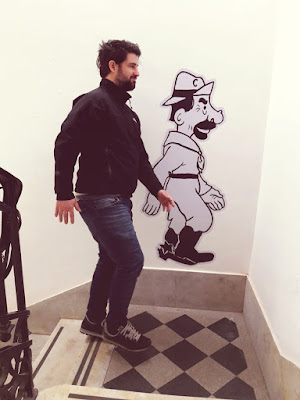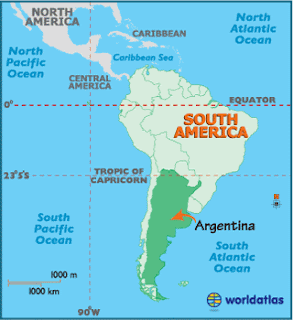Nagu Moreno is one of our very talented graduates from animation program. Throughout his time at AnimSchool, he won the hearts of his instructors through sheer dedication and hard work. We recently got a chance to interview him for our blog and learn more about him, and his workflow.
Tell us about yourself and your background.
 |
| Nagu imitating the work of Quirino Cristiani: a local animator |
I was born in Buenos Aires, Argentina, I work and live here. For as long as I can remember I was passionate about animation. It may be not a very original story but the truth is that as a child I always said, I wanted to make cartoons when I grew up. I was fascinated by all cartoons, but my favorite was The Pink Panther Show. I spent hours drawing the characters so much that my mom enrolled me in a drawing class. I also enjoyed acting and everyone knew me for making impressions of imaginary characters or our school teachers. Later I studied acting, theater and performance for a couple of years. After I finished high school, I was a bit shy and somewhat confused and ended up studying Marine Biology for some time - I love animals, especially the weird ones, but I’m not so good at STEM subjects. Later because of my interest in movies I studied towards a degree in Sound and Image Design in University of Buenos Aires (UBA), getting closer to animation although I didn’t realize it then. I love all kinds of animation, all techniques and styles.
In my free time, besides animation, I enjoy playing football and traveling when possible.
So what motivated you to become an animator?
I first discovered 3D as an animation technique when I was in college. I remember leaving the cinema after watching Monsters, Inc. absolutely fascinated. I realized that this was what I wanted to do, so I quit my job at the supermarket and with just enough money enrolled in a intensive course at a private university which focused on all areas of the 3D world, all the while studying in college. I saw it as a self-investment and a chance to work on something I enjoy. Although in my country animation schools are few and far between and the industry has a long way to go, the course served as a great introduction to the industry, and I soon started working as a 3D generalist for movies and advertising companies in various local production studios.
From the beginning, I was most of all interested in animating characters – to make each gesture and expression come alive to me means everything I love about this world, which is why I decided to focus on Character Animation.
What made you choose AnimSchool?
 |
| AnimSchool's Marina Character design |
I learned a lot about the production workflow of a full-length animated movie while working in Underdogs, a movie which was partly made in my country, but not so much about character animation due to the position I was working in.
I remember stumbling upon AnimSchool showcases and loving the students’ work and the rigs; the characters looked very expressive and versatile, but enrolling seemed impossible because of time and cost. I learned more about AnimSchool from my coworker Maximiliano, who was a student here. It made me happy to know that my wish to become a better animator and learn from the best animators in the industry had a name and a place and was something real and approachable.
Tell us about your workflow.
While choosing an audio I try to visualize possible camera angles and framing. I believe that although my dialogue shot begins and ends in a specific time frame, the story must continue before and after the shot. So it should not be a stand-alone but rather part of a bigger story arc and my shot is able to convey that feeling. Therefore it is very important for me to choose those settings and elements that would help the viewer to quickly figure out what is happening and where the shot is leading to.
My pre-planning involves drawing thumbnails. I like acting the scenes out in front of the mirror. After getting a general idea of the acting, I film a reference, trying to identify the key moments and poses which are crucial for telling the story.
 |
| Click for bigger view |
With several video references filmed, I piece parts of them together to make a final version. As I tend to exaggerate the acting or the number of poses, which may have something to do with me being a Latin American with Italian roots, I always watch out for it and try to tone down and simplify the final version.
Then I draw some quick frames with key poses and extremes and turn them into a sequence with a timeline in an editing program. Now I have an animatic which helps me to check quickly if the timing of my animation is right and to make the poses clearer.
Time to start working in 3D – I first work on the key poses, mainly the body - I don’t touch the face, just some quick expressions so it doesn’t look too neutral. I try to get as many body mechanics references from my video as I can and adapt them to the character’s weight and physical aptitudes. I start working with curves in step mode as I feel more comfortable with pure blocking. The master poses finished, I work on the extremes and add breakdowns, going from bigger to smaller and trying to make the pose to pose changes look natural, so I work on the ease-ins and ease-outs, movement arcs and adding facial expressions little by little.
When I’m happy with my body/facial blocking and I feel that it flows naturally without spacing jumps and the timing is right, I start animating the lip sync and blinking with spline curves. After that I add little details I see in my references I may have not noticed before, which may be help the character come to life, like a sigh or an eye dart. I like to consult others’ opinion while working, not necessarily someone who knows about animation. It helps me see if my idea is clear to others, or work out a gesture or in general have a new and different perspective. Then I pass the animation to spline and start polishing the curves and retouching everything to recover the beats I had in my blocking which now may look a bit too smooth. While in blocking I work mainly on the timeline from start to end, here I polish the curves in chunks, dividing the animation in about three parts. I work on general controls hierarchy first, moving on to the details, generally hips, then torso, neck and head and the limbs, etc.
Were you working before joining AnimSchool? And now that you have graduated from the animation program, what are your plans?
I have mainly worked in audiovisual studios here in Argentina and although I have worked in full length films, mostly locally, the bulk of my experience is as a 3D generalist in commercials. As a generalist I realized I cannot improve my skills if I have to work on every step of the project (modelling, lighting, etc.), especially with timing and resources available when making a commercial. My first step was to focus on character animation and make a leap in quality I felt I badly needed. At the moment my end plan is to be able to work on high quality fully animated movies, while continuing with my studies, learning and improving my skills.
What is the animation industry like in Argentina? Do you think it has the potential to grow?

Argentina’s animation industry is mainly dedicated to advertising. There are a number of studios that specialize in commercials that produce a decent quality content.
Argentina has a humble but significant place in the history of world animation since the beginning of the 20th century. However, attempts in animation here have always been isolated and independent, often without a definite idea of a long-term project.
That said, in my opinion it’s witnessing a rise, there is a new generation of professional animators, who can learn quickly thanks to how easily you can access information and technology these days. The only thing needed is more options in professional education and most of all structured degrees in animation as a separate discipline, independent of a degree in cinema.
What would your advice be for the aspiring animators?
Use everything AnimSchool has to offer - general reviews, art classes, etc. For me personally it was very useful asking for feedback and even having reviews with my classmates who could offer a fresher outside perspective. At the same time, all my instructors were very open to communication and questioning, and were always ready to share their workflow, which was extremely helpful.
In my opinion the result is worth the effort, the same way a shot may look vague in the beginning and then takes form with every key pose until eventually coming to life. This is what happens at the end of the program: you realize how much you have learned, and although you can always improve, the knowledge you have is already yours and stays with you forever.
Thank you Nagu for your time and the interview.



















